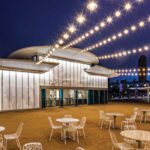
Photo courtesy of Chad Copeland
A comprehensive, multiyear renovation project modernized the Space Needle attraction. Ten types of glass replaced entire walls, barriers and floors, and the project almost doubled the amount of glazing compared to the previous design. In addition to the glass walls, the project included, glass barriers, glass floors and glass benches.
Glazing at the exterior of the observation deck and restaurant level was rebuilt with floor-to-ceiling insulating glass units (IGUs), which incorporated warm-edge thermal breaks.
Helen Sanders, Ph.D., of Technoform, says the glass walls were customized for the project as a reverse curtainwall. “It created a smooth surface on the inside to allow viewers to have less physical obstructions to getting close up to the glass,” she says. “As a result, the deep mullions that would have been on the inside are on the outside and act as a heat sink with very little in the way of a thermal break between it and the glass edge.”
The warm-edge thermal breaks were essential in the design. In addition to thermal efficiency, they provided the required edge seal rigidity.
Richard Green, PE, principal at Front Inc., glazing consultant and designer for the project, says, “The only thermal separation we have is in the small thermal spacer [between the mullion and the glass] and in the IGU seals, making Technoform’s spacer super important in both thermal performance and condensation resistance.”
Warm-edge spacers are typically needed only in cold weather to keep interior temperatures warmer compared to outside, Sanders says. “However, in this case, the reduction in solar heat gain is a key driver for the use of warm-edge spacer. [On the Space Needle], the exterior mullion absorbs the solar radiation, and then this heat would conduct across the glass edge to the room side, if not for the warm-edge spacer. This thermal break performance helped reduce the cooling load on the chiller, which normally wouldn’t be associated with warm-edge spacer.”
In addition to the warm-edge spacers, the IGUs provided energy efficiency. “The project utilized a 196 percent increase in glazed area and also needed to consider the relatively poor thermal performance of the opaque areas, where the existing structure passed from exterior to interior at many points without thermal separation,” Sanders says. “Because thermal improvements in those opaque areas were limited, the onus was on the glazing to provide excellent energy performance.”
Pulp Studio Inc. fabricated 8-foot-long by 7-foot-wide, double-laminated IGUs with a neutral, triple silver, low-E coating for solar control, and anti-reflective coatings to maximize views. The IGUs have Vitro Architectural Glass’ low-E coating and Glas Trösch’s antireflection coatings.
Additionally, the IGUs have two glass interlayers, which add energy efficiency to the frameless glazing application. Kuraray America Inc. supplied its SentryGlas interlayer, and Vanceva, a subsidiary of Eastman Chemical Co., supplied its glass interlayer. On glass edges, Pulp Studio fabricated the IGUs with Technoform’s 5/8-inch-wide, rigid bar, TGI-Spacer M with wire. On the job site, Herzog Glass Inc. installed the IGUs.
The Space Needle is 605 feet above ground level. It was built in 1962 for the Century 21 Exposition, Seattle’s World’s Fair.






